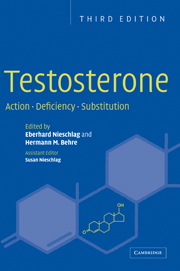Book contents
- Frontmatter
- Contents
- List of contributors
- Preface
- 1 Testosterone: an overview of biosynthesis, transport, metabolism and non-genomic actions
- 2 The androgen receptor: molecular biology
- 3 Androgen receptor: pathophysiology
- 4 Behavioural correlates of testosterone
- 5 The role of testosterone in spermatogenesis
- 6 Androgens and hair: a biological paradox
- 7 Androgens and bone metabolism
- 8 Testosterone effects on the skeletal muscle
- 9 Androgens and erythropoiesis
- 10 Testosterone and cardiovascular diseases
- 11 Testosterone and erection
- 12 Testosterone and the prostate
- 13 Clinical uses of testosterone in hypogonadism and other conditions
- 14 Pharmacology of testosterone preparations
- 15 Androgen therapy in non-gonadal disease
- 16 Androgens in male senescence
- 17 The pathobiology of androgens in women
- 18 Clinical use of 5α-reductase inhibitors
- 19 Dehydroepiandrosterone (DHEA) and androstenedione
- 20 Selective androgen receptor modulators (SARMs)
- 21 Methodology for measuring testosterone, DHT and SHBG in a clinical setting
- 22 Synthesis and pharmacological profiling of new orally active steroidal androgens
- 23 Hormonal male contraception: the essential role of testosterone
- 24 Abuse of androgens and detection of illegal use
- Subject Index
20 - Selective androgen receptor modulators (SARMs)
Published online by Cambridge University Press: 18 January 2010
- Frontmatter
- Contents
- List of contributors
- Preface
- 1 Testosterone: an overview of biosynthesis, transport, metabolism and non-genomic actions
- 2 The androgen receptor: molecular biology
- 3 Androgen receptor: pathophysiology
- 4 Behavioural correlates of testosterone
- 5 The role of testosterone in spermatogenesis
- 6 Androgens and hair: a biological paradox
- 7 Androgens and bone metabolism
- 8 Testosterone effects on the skeletal muscle
- 9 Androgens and erythropoiesis
- 10 Testosterone and cardiovascular diseases
- 11 Testosterone and erection
- 12 Testosterone and the prostate
- 13 Clinical uses of testosterone in hypogonadism and other conditions
- 14 Pharmacology of testosterone preparations
- 15 Androgen therapy in non-gonadal disease
- 16 Androgens in male senescence
- 17 The pathobiology of androgens in women
- 18 Clinical use of 5α-reductase inhibitors
- 19 Dehydroepiandrosterone (DHEA) and androstenedione
- 20 Selective androgen receptor modulators (SARMs)
- 21 Methodology for measuring testosterone, DHT and SHBG in a clinical setting
- 22 Synthesis and pharmacological profiling of new orally active steroidal androgens
- 23 Hormonal male contraception: the essential role of testosterone
- 24 Abuse of androgens and detection of illegal use
- Subject Index
Summary
Introduction
Nuclear hormone receptors (NHRs) as members of the nuclear receptor (NR) gene family that regulate a wide range of physiological and pathophysiological effects, are activated through binding of small ligands (hormones), and acting as transcription factors by interaction with distinct DNA motifs on gene promoter to control target gene transcription. Because this mechanism is similar in all tissues it was highly interesting to discover that specific ligands have selective effects on target genes and target tissues, opening up the concept of creating selective NHR modulators for particular therapeutic endpoints. A group of compounds were described that function as estrogen receptor (ER) agonists in some tissues (e.g. bone) but have opposite estrogen action in others (e.g. breast), establishing the concept of selective estrogen receptor modulators (SERMs) and are already available as drugs (Cosman and Lindsay 1999). From the molecular mode of action on the nuclear receptor, SERMs are characterised as mixed agonists/antagonists as measurable in cell culture using reporter gene assays in the absence or presence of the ligand. This mixed behaviour in cell culture is reflected by their in vivo action, and both, agonistic and antagonistic properties may be combined in selected target organs (Katzenellenbogen and Katzenellenbogen 2002). In the agonistic conformation as shown in LBD crystal structure of ERα in complex with estradiol (E2), the helix-12 is in the ligand binding pocket in complex with the agonist, but displaced in the antagonist complex with raloxifen (Brzozowski et al. 1997).
- Type
- Chapter
- Information
- TestosteroneAction, Deficiency, Substitution, pp. 623 - 640Publisher: Cambridge University PressPrint publication year: 2004
- 2
- Cited by

